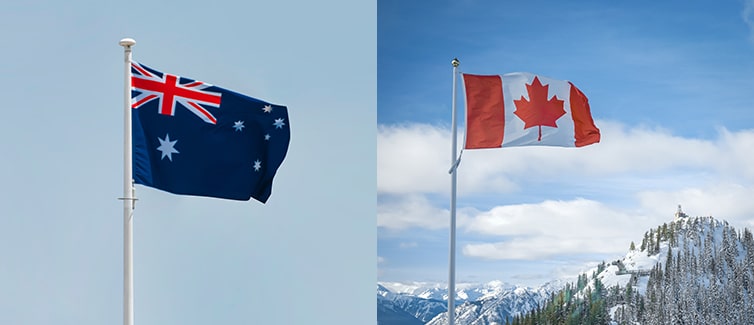We're moving! This site will be relocating to goingto.university in 2026. Please update your bookmarks to the new address.


Canada and Australia represent two of the world’s top five study destinations for international students today.
Interestingly, both countries have become home to an increasingly large number of international students in the past few years and today, both countries welcome over 500,000 international students from all cultures and nationalities every year!
Over the next twenty years, both Canada and Australia are expected to become two of the world’s top international student destinations.
With a population of about 40 million residents, Canada is a major global hub for industries such as trade and energy. Three Canadian cities – Calgary, Toronto and Vancouver – consistently feature in the top 10 of various Liveability Index lists, proof that the country is a highly-developed and modern country for residents.
Canada offers 31 universities in the latest QS Global University Rankings. Universities across the country have gained excellent reputations for their advanced research and academic facilities, top-quality faculty and welcoming campus life, whether on urban campuses or in rural regions.
Canada offers you long-term post-graduation employment visas, a big attraction for many international students who would like to settle in the country and secure a job. This is one of the major reasons why Canada has seen its international student population nearly triple in the last ten years alone!
Situated in the southern hemisphere and with a total population of about 25 million residents, Australia offers both world-class city life as well as excellent outdoor experiences and healthy living.
Australia has become a tourist and student-favourite destination in recent years because of its high-quality educational infrastructure, well-connected transport, excellent living standards and world-class cities full of vibrant outdoors and entertainment activities.
Major Australian cities including Melbourne receive high scores from QS Global University Rankings for tolerance and social inclusion which indicates the levels of comfort and safety for international students in Australia.
Australia also offers a strong sporting culture and plenty of opportunities to explore the countryside and the ocean. International students in the country can remain healthy through outdoor activities and exercise, and explore exciting natural landmarks during their time away from the classroom. Australia is well-known for its relaxed culture and vibrant entertainment venues in every major city.
Australia is home to 38 universities featured in the 2024 QS Global University Rankings, with five universities in the global top 50.
Australia also offers a specialised set of degrees via institutions known as TAFEs (Technical and Further Education). These degrees give you vocational expertise and allow international students to secure valuable internship experiences with top employers across industries in Australia. In Australia, all undergraduate programmes last three years.
When it comes to tuition expenses for international students, Canada is a more affordable choice than Australia in most cases. Average undergraduate tuition fees in Canada range between 11,000-16,000 US Dollars per annum for international students, whereas postgraduate tuition fees are slightly more expensive between 14,000-20,000 US Dollars per year.
In contrast, international students may have to pay up to 25,000 US Dollars per year at Australian universities, and up to 32,000 US Dollars per annum for postgraduate degree programmes. PhD degree programmes are also far more affordable for international students in Canada than in Australia, whereas MBA degree programmes in Canada are usually half the price of similar programmes in Australia.
When it comes to average living costs in both countries for international students, Canada again offers a far more affordable living budget than Australia. The average living cost in Canada is usually between 800-1,000 US Dollars per month, but international students in Australia generally rack up expenses of up to 1,200 US Dollars per month.
As both countries offer world-class lifestyles, public transport and public safety, living expenses in Canada seem excellent value for money for international students. This is also the case with the visa application fees for both countries. While international students must pay a visa application fee of 110 US Dollars for a Canadian Visa, student visa applications to Australia cost at least 400 US Dollars.
In terms of the job market and opportunities to secure jobs for international students, both Canada and Australia offer excellent employment chances for you after graduation at a university.
For post-graduation employment, Australia offers international students a Temporary Graduate (Subclass 485) visa that allows you to stay and work in Australia for a period between 18 months and 4 years, depending on your qualification.
In Canada, international students receive a Post-Graduate Work Visa within 90 days of graduation that enables you to work at Canadian firms for a period of at least three years.
Major industries with high-paying jobs in Australia include engineering, hospitality, nursing, medicine, finance, and law. An added benefit of Australian universities is that most of them organise student placement events to help you secure a job after graduation.
In Canada, you will need to search and locate ideal jobs by yourself after graduation. Major Canadian sectors and industries include media, teaching, industrial design and metallurgy.
Another key reason why international students decide to study at Canadian and Australian universities is in order to emigrate to the countries and settle there after graduation. In this aspect, Canada provides a relatively straightforward and simple process for international students to acquire Permanent Residency (PR) status, while in Australia the process for getting a PR is slightly longer and more complicated. In Canada, a country with a shortage of highly skilled workers at the moment, you can apply for PR if you currently have a Post Graduate Work Permit (PGWP).
By contrast, applications for a Skilled Independent visa (subclass 189) are Australia’s version of Permanent Residency permit. Australia requires far more assessments from international students in order to grant residency, and their points system for awarding it means that it usually takes far more time in Australia than in Canada. The most successful method of applying for residency in Australia is to apply for an Employer Sponsored Visa, which you can do once you have worked for three years in Australia, after graduation.
Last but not least, international students should take note of the differences in climate between Australia and Canada. The climate and weather conditions can have a major impact on your mental and physical health while you are studying, so you should carefully consider the climate conditions in any country before making a decision.
In most Australian cities, known for their sunny beaches and pleasant coastal climate, the average year-long temperature ranges between 25-32 degrees Celsius. By contrast, Canada is known as one of the world’s coldest countries and its average temperature is around -5 degrees Celsius! You can expect at least five to seven months of snowfall and wintery weather in most parts of Canada, especially the cities in the east such as Toronto and Ottawa.
If the cold winters are not something you would enjoy as an international student, Australia might be a better choice for you. Meanwhile, if residency status and affordable tuition & living expenses are your key decision-making factors when choosing between the two countries, Canada might be more appealing.
With both countries providing excellent quality of life and educational infrastructure, you will have a great time in both Australia and Canada whether you are busy with academics or having fun outside the classroom.
The latest articles from study abroad providers and StudyLink.com to hep you on your study abroad journey.
See more articlesRead our key advice article to help you make the best decision for your education and start your International study adventure.

In this article we look at how to approach choosing where in the world you would like to study.

Read StudyLink's suggestions on your first steps when deciding where to study abroad, with helpful tips to make your decision easier.

Find out more about English language tests, your options and what is required as an overseas student.

StudyLink.com take a detailed look into the costs of studying abroad and all the aspects that you should budget for when embarking on your studies.

We answer 10 common questions about applying for a student visa to help make your visa application quick and easy.

Find out more about international student visas for studying abroad, as well as how, where and when to apply for yours.

Find out more about funding and scholarships for international students, and what financial assistance might be available to you.

How to choose a course that fits you? Check our top tips on choosing which course is best for you to help you make an informed decision.
Join the StudyLink email list and never miss a chance to turn your study abroad dreams into reality!
